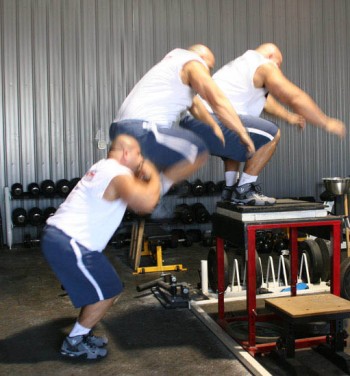Earlier this week I had a discussion with one of the better, for sake of a better word let use, “athletes” at work….
He’s early to mid 30’s in really good shape and ran track in college, now he’s part of a special campus security team. He asked me about “plyometric” workouts…..
I knew it was going to be bad….
It was
he had gotten a workout off of the interwebzzz that called for 3 sets of 3 exercises for sets of 10-12 each…..
plyo’s are NOT body building…nor should we use the DeLorme method.
It just ain’t right….plyometrics are about speed and power. So this is the basics of what I told him:
First off 99% of what people call plyometric is not at all. Don’t believe me? What about the National Strength and Conditioning Association,
Even though plyometrics have been around for decades, many coaches still remain misinformed on how to properly incorporate plyometrics into their athlete’s training plans. Others fail to understand or apply the scientific theories behind this unique methodology of training.- Shawn Myszka
“Plyometric” is a western term (we made it up) which comes from what was termed by Dr. Yuri Verkhoshansky as “shock training”.
NOT a true plyometric exercise
True “plyometric” or “shock” training requires a large eccentric force to be coupled with a concentric force resulting in a very large resultant force.
The most famous exercise which is used in the “shock” method is the depth jump;
stand on a box, step off, hit the ground, and immediately jump up as high as possible at ground contact. You should gain energy from the impact that you absorb, stabilize, and transfer to your muscles and tendons for a more explosive jump. – Kelly Bagggett
Obviously, this is very different from the exercises that most people call plyometric such as box jumps and broad jumps where there is no coupling of the eccentric and concentric contractions or amortization phase.
The goal of plyometrics is to ultimately enhance the Stretch Shortening Cycle (SSC) of the muscles and tendons. The athlete needs the eccentric loading provided by stepping off the box (height of the fall) for the SSC to really be challenged and trained.
For the most part true plyometric training is out of the question for most people.
It’s just too stressful on the body. The vast majority of people can not absorb the types of forces that are associated with this type of training….Remember…
MOST OF THE FORCES ARE TRANSFERRED THROUGH YOUR TENDONS!
Not the muscles.
Don’t forget tendons are what attaches muscle to bone….If your knees hurt now just think about how they’ll feel after a nice series of depth jumps.
Strength is a hotly debated issue in regards to how strong is strong enough for plyo’s.
Some say you should refrain from plyometric training until you can squat 1.5-2 times your body weight.
I don’t know about that.
That’s a pretty big squat for most people, but in regards to depth jumps and their ilk, I think I do agree with that because the eccentric forces being absorbed are so large. If nothing else, to squat that kind of weight, you would have to have a good body awareness and control.
That said pseudo plyometric drills like vertical jumps, box jumps etc, a little strength would be good (enough to control the landings) but I don’t think that 1.2-2 x’s body-weight squat type of strength is needed. Maybe a squat equal to 75-90% of body weight should suffice.
Now, before I get the angry Mike Boyle, CrossFitt nut hanger who goes, “My kids jump off play ground equipment all day and their fine” argument..
NO SH@T…...
I’m not talking about you 55lbs kid who is active and runs, jumps, moves has good mechanics etc.
I’m talking about an adult who mostly stands around or sits at a desk, has bad mechanics, orthopedic restrictions and weighs 200lbs doing depth jumps….not box jumps or landings….
And if you listened to the ENTIRE statement Coach Boyle makes about the whole plyometric things you would realize he agrees…
Even the NSCA says,
Not that they are the end all be all but that seems to be the consensus.
Once we understand what we’re doing and what we need to be able to do this the question becomes..How much?
Answer: Not Much
Remember plyos are explosive and result in the body absorbing and producing large forces. Big forces are stressful to the body.
Yeah, you may make it though the workout, but will you make it through the next one?
When it comes to true plyos less is almost always more. It’s easy to overtrain these. Remember the words of Charlie Francis, ” it is always better to undertrain than to overtrain“.
If you can’t recover, you can’t improve.
While there are guidelines for plyometric volume in a workout….the honest answer is, it depends.
Training age, strength levels, the intensity (height of drop, number of consecutive jumps, etc), goal of the training session and cycle all need to be taken into consideration.
Remember,
“these are a speed-strength tool not an endurance tool. Maximum muscular recruitment requires that you stay fresh. High volumes of consecutive repetitions are not possible or advisable.” –Kelly Baggett .
Keep em quick and explosive.
Less than 20 ground contacts for things like depth jumps is probably good, 20-50 things like box jumps, cone hops, skater strides is probably enough there for most people.
That’s the quick and dirty basics of plyometrics….next time you hear someone go, “I love plyos. They make you sweat a lot”….or that they “did the plyometrics on P90X” understand that they have been BADLY misinformed and have no clue what’s going on…
Great video on Dr. Verkhoshansky and plyos: If you are an athlete of train athletes well worth your time, if not…skip it.





plyos arent rocket science. your an idiot. any box jump or even jump rope is plyometric by definition.
your article is drama.
Stacey,
I would agree that jumping rope is inherently Plyometric but Box Jumps, by definition, most definitely are not. Box Jumps lack an amortization phase.
You’re right, they’re not rocket science but most people are not using actual Plyometrics and are using inappropriate loading patterns.
If you’re interested in Plyo’s I would recommend looking up Dr Natalia Verkhoshansky, her father developed plyometrics and she still lectures on them regularly.
The last several years she’s lectured on them at this seminar:
http://www.cvasps.com/
Bret Contreras did a nice interview with her here:
http://bretcontreras.com/interview_natalia_verkhoshansky/
Sorry you think I’m being dramatic, but words/ terms have meanings and context and it’s important to adhere to those meanings when using terms to provide accuracy, prevent misunderstandings and provide clarity on subjects.
Anyway, thanks for reading.
Wrong!
Ron,
Wrong about what?